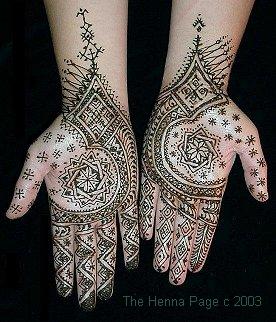


|
Archaeological and anthropological evidence indicate that henna traditions had early origins in the eastern coast of the Mediterranean, Nubia, Libya, Tunisia, Arabia, Assyria, Mesopotamia, Persia, and India. These traditions sometimes merged or moved through cultural transmission, sometimes they became innovative when there periods of wealth and leisure, sometimes they vanished in cultural or climate change. Henna use and traditions began in the late Neolithic period, were included in animist religions in these areas, and later incorporated into Judaism, Christianity, Islam, Buddhism and Hinduism. The common ground of these traditions is the henna plant itself: it can only grow in a narrow ecological range. This climate range, that of heat and drought, puts a unique set of stressors on human populations, and the henna traditions frequently reflect concerns with these stressors. The Henna Page Traditions
are part of the Encyclopedia
of Henna. Look for specific
traditions in the index of The Encyclopedia
of Henna. |